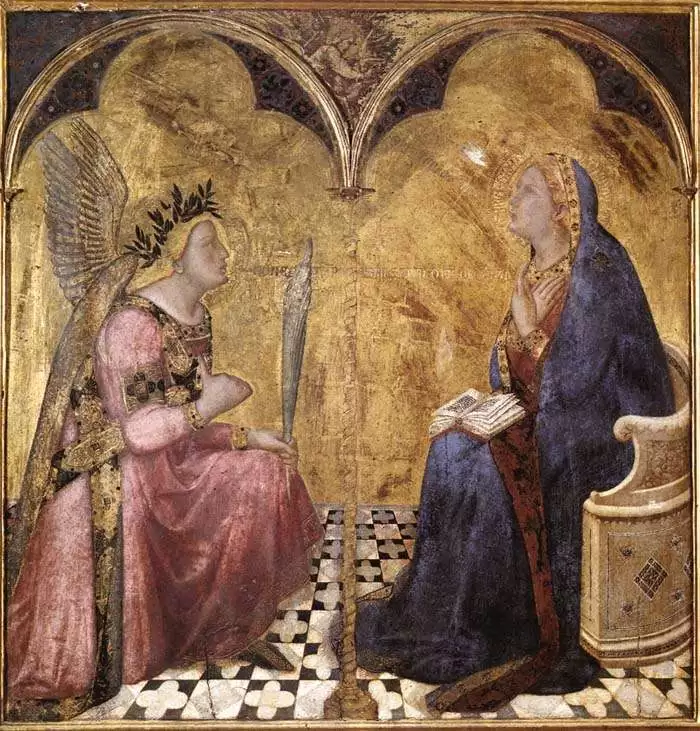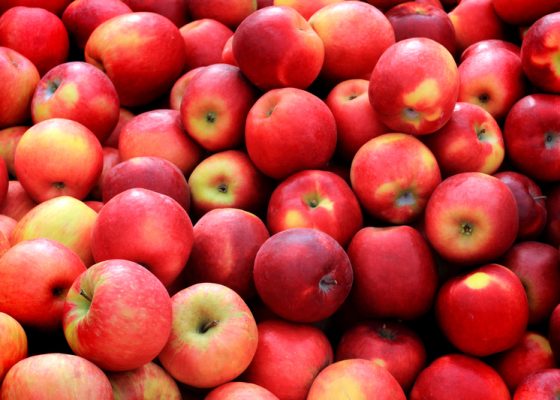
By Alice Moore
Ambrogio Lorenzetti (Siena, ca. 1290 – Siena, 1348) was an Italian painter of the Sienese school. He was active between approximately from 1317 to 1348. After the departure of Simone Martini to Avignon in 1336, Ambrogio established a workshop in Siena.
His elder brother was the painter Pietro Lorenzetti. They were the first Sienese to adopt the dramatic quality of the Tuscan sculptor Giovanni Pisano and the naturalistic approach of the Florentine painter Giotto. In their experiments with three-dimensional, spatial arrangements, the brothers, particularly Ambrogio, foreshadowed the art of the Renaissance. Ambrogio, more realistic, inventive, and influential than Pietro, is best known for the fresco cycles Good Government and Bad Government (1338-39, Palazzo Publico, Siena), remarkable for their depiction of character and of the Sienese scene. He also painted Presentation in the Temple (1342, Uffizi, Florence) and Annunciation (1344, Pinacoteca, Siena). His work includes also the altarpiece Madonna and Child with Saints (1320, Santa Maria Della Pieve, Arezzo), dramatic frescoes in the lower Church of San Francisco in Assisi, and the Birth of the Virgin (C. 1342, Opera del Duomo, Siena).
The peaceful and gently lyrical temperament of Ambrogio Lorenzetti is in complete contrast to bis brother’s fiery and often intensely dramatic spirit. Vasari did not realize that the two were related, and wrote of Ambrogio that bis manners “were. .. more those of a gentleman and philosopher than those of an artist,” and he speaks about his love of literature and bis intellectual acumen, qualities that enabled him to turn bis hand both to sacred painting and to historical, allegorical and other “profane” themes, to pick up hints from classical antiquity and from the fabled Orient, to be a cosmographer and cartographer, and above all to bring profundity and boldness of ideas to bis work, and to revolutionize accepted notions of iconography.[1]
Ambrogio Lorenzetti died from a plague in 1348.
The Annunciation (1344). In this late and highly finished work Ambrogio abandons his usual earthy depiction of realistic and human detail in favour of emphasizing the almost Gothic elegance of the two characters. They face each other across a floor that is, however, painted in rigorous perspective. The signed and dated painting was executed in 1344 for the City Council of Siena.
The Annunciation is one of the five signed and dated works of Lorenzetti, the last in chronological order, and therefore a valid reference point for the dating of the remaining works attributed to this artist. Ambrogio Lorenzetti’s Annunciation (…) has been justly acclaimed by contemporary scholars as one of his finest creations. It has also received a fair amount of criticism. In particular, scholars have faulted the heaviness of the figures, the awkwardness of Gabriel’s gesture, and his diminutive extended wings, which have been roundly condemned as a crude restoration.[6]
Ambrogio Lorenzetti’s most revolutionary achievement – one of the most remarkable accomplishments of the Renaissance – is the fresco series that lines three walls of the room in the Palazzo Pubblico where Siena’s chief magistrates, the Nine, held their meetings (Sala dei Nove). These frescoes are collectively known as Allegory and Effects of Good and Bad Government.
The Allegory of Good Government depicts the personification of Justice as a woman. She gestures to the scales of balance, held by the personifcation of Wisdom floating over her throne. On the viewer’s left, a convicted criminal is beheaded; on the right, figures receive the rewards of justice. At Justice’s feet, the personification of Virtue, also, unusually for the time, portrayed as a female figure, passes virtue among twenty four faithfully rendered and recognizable images of prominent male citizens of Siena. The men face towards the largest figure in the image, a judge located in the center right. The judge is surrounded by additional personifications including Peace, who is represented as a fashionable, white-clad contemporary female figure with elaborate blonde hair. (Then as now, blonde hair was fashionable and seldom entirely natural; it was not the dominant natural hair color for Italian women from this region, and it was common for women to lighten their hair by streaking it with urine and heating it in the sun.)
The allegory carries a strong social message of the value of the stable republican government of Siena. It combines elements of secular life with references to the importance of religion in the city at the time. The figure of Justice resembles the figure of Mary, Queen of Heaven, the patron saint of Siena, on a throne. The Judge reflects the tradition in the Christian Last Judgment to have God or Christ judging the saved on the left; the damned on the right. While classified as medieval or proto (pre)-renaissance art, these paintings show a transition in thought and an evolution in theme from earlier religious art.
Flanking the Allegory are two other paintings on perpendicular walls: Effects of Good Government and Effects of Bad Government. Both these frescoes depict a recognizable view of Siena and its countryside.
In the allegorical representation of Good Government, the prosperous townspeople are trading and dancing in the streets. Beyond the city walls is a lush countryside in which crops are harvested.
In the allegory of Bad Government, crime is rampant and diseased citizens roam a crumbling city. The countryside suffers from drought.
Allegory of the Good Government, fresco in the Palazzo Pubblico, Siena
Ambrogio Lorenzetti frescoed the side walls of the Council Room (Sala dei Nove) of the City Hall, the Palazzo Pubblico, of Siena. The subject of the frescoes are the Good and Bad Government and their effects on the life of the cities and villages.
The Allegory of the Good Government is situated on the smaller wall opposite to the windows. The composition is built up from three horizontal bands. In the foreground the figures of contemporary Siena are represented. Behind them, on a stage, there are allegoric figures in two groups, representing the Good Government. The two groups are connected by the procession of the councillors. The upper band indicates the heavenly sphere with the floating bodyless ghosts of the virtues.
The enthroned man on the right side of the middle band represents the city of Siena and embodies the Good Government. Around his head the four letters C S C V (Commune Saenorum Civitatis Virginis) explain his identity. At his feet the two plating children are the sons of Remus, Ascius and Senius, the founders of Siena according to the Roman legends. On both sides of Siena the virtues of Good Government are represented by six crowned, stately female figures: Peace, Fortitude and Prudence on the left, Magnanimity, Temperance and Justice on the right. On the far left of the fresco the figure of Justice is repeated as she is balancing the scales held by Wisdom.

The Effect of the Good Goverment is situated on the longer wall of the room. This panoramic fresco represents several scenes indicating the life of Siena and its environment in the 14th century. This detail shows the centre of the city. In the middle the dancing young women probably represent the nine Muses. There are several genre like scenes in the picture (shops, chatting men, riders, working men on the roof etc.)

Bad Government and the Effects of Bad Government on the City Life
On the wall opposite the Effect of Good Government and to the left of the Good Government Ambrogio painted another fresco called Bad Government and the Effects of Bad Government on the City Life, which uses the same forms and compositional devices as the other frescoes in the room, but inverts them. The malevolent-looking figure representing Bad Government, pointedly labeled as Tyranny, is enthroned and stares hieratically out at the observer.. Neither male nor female, it is fanged, cross-eyed, and porcine, clearly bloated with corruption. In place of the cardinal virtues, personifications of Avarice, Pride, and Vainglory fly over its head. Tyranny is flanked by clearly labeled seated figures representing Cruelty, Treason, and Fraud at the left, and Frenzy, Divisiveness, and War at the right. A bound figure representing Justice lies at its feet. The city to its left is falling into ruin, robbers roam the streets, and, in the foreground, a group of ruffians drags a woman by her hair. Even in its now ruinous condition the image conveys a dire warning.

Effects of Bad Government on the Countryside (detail)
In the hilly countryside the only activities are ones of death and destruction, setting fire to isolated houses and whole villages. The countryside is bare and barren, the trees bear no fruit and no one is cultivating the land.
The Allegory of the Bad Goverment is situated on the wall opposite to Allegory of Good Government. At the centre of the dais sits Tyrannia, with the appearence of a demon, with horns and fangs. The figure of Tyranny has flowing woman’s hair, a cloak with gold embroidery and precious stones, a gold cup in her hand and a goat, the traditional symbol of lust, at her feet. Below is the vanquised Justitia: the scales are broken and scattered around her on the ground. Around Tyranny’s throne are gathered the Vices.
The Funeral of the Virgin
This fresco is located on the north wall of the Cappella dei Signori in the Palazzo Pubblico. The Cappella dei Signori was constructed in about 1404-05 on the first floor of the Palazzo Pubblico, next to the important Sala del Mappamondo. As soon as the Cappella dei Signori was finished, the government commissioned Taddeo di Bartolo to paint its walls and vaulting, paying him for the work at regular intervals between 1406 and 1408.
The north wall of the chapel is embellished with four large mural paintings depicting events surrounding the death of the Virgin – the arrival of the apostles at her death bed, Christ receiving her soul at the moment of her death, the funeral procession to her burial site and Christ raising the body of the Virgin from her tomb. The Funeral of the Virgin in particular offers a sense of Taddeo di Bartolo’s considerable abilities as a painter of narrative: the foreground is occupied by an impressive procession of monumentally conceived figures of different ages, genders and ethnic types. In the background, meanwhile, appears an assured view of a walled city, the buildings of which resemble those of Siena itself, yet making an implicit parallel between the holy city of Jerusalem and Siena.
One of the high points of small-scale Sienese painting is the so-called Small Maestà by Ambrogio Lorenzetti. Though small, it is breathtakingly beautiful. First of all there is the dazzling gold setting off the Madonna’s outline, with angels emerging from it. Then there is the quality of color. Rarely in early Italian art does one find such as intense red, and in almost no other work has the costly lapis lazuli of the blue been so well preserved. Each part of the scene demands individual attention: the extremely delicate ornamentation and draughtmanship of the draperies, the saints’ faces, and the magnificent display of color of the flowers in the golden vase in the foreground.
Of all the features of this unique painting, one does not at first notice its spatial organization. The radiance tends to mask the structure of the composition, yet this is perhaps the most remarkable aspect of the work. Here Ambrogio has resolved an artistic challenge that he also set himself in a large Maestà at Massa Marittima. The Small Maestà can be considered as an improved version of the Maestà at Massa Marittima.
In the center of the painting the Madonna is enthroned with the Christ Child, six angels flanking the throne at the back. On the left St Elizabeth of Hungary, on the right ST Catherine of Alexandria; kneeling on the left St Nicholas (?), in the left foreground Pope Clement I; on the right St Martin (?), in the right foreground Pope Gregory I can be seen.[3]
The painting (Madonna del’latte) is related to the earlier Madonna of Vico l’Abate, it demontrates the changes in the art of Ambrogio due to the influence of his elder brother Pietro with whom he worked together in the second half of the 1320s in the Franciscan monastery in Siena.
Basilica of San Francesco, Siena

The Gothic Basilica di San Francesco (1326-1475) is a Franciscan church situated in the historical centre of Siena, at the end of via dei Rossi. Like the Basilica di San Domenico, the church has one nave and no apse. The bell tower was built in 1765. The church has a wooden roof and the interior painted with black and white stripes recalls the marble façade of the Cathedral.
The first chapel to the left of the presbytery contains Pietro Lorenzetti’s fresco of the Crucifixion, painted in 1331. The second chapel in the left hand section of the transept contains a further two masterpieces by Ambrogio Lorenzetti, two frescoes depicting St Ludovico of Anjou Before Boniface VIII and the Six Franciscans Martyred at Ceuta.
Opposite is the Chapel of the Sacrament, decorated by Marrina in 1502. A door to the left leads to the spacious and delicately proportioned Renaissance cloister, which contains a number of sculpture fragments such as the Portale della Cappella Petroni (1336) attributed to Domenico D’Agostino. The right hand door leads to the Seminary, where the chapel on the floor above contains the well known Madonna del Latte by Ambrogio Lorenzetti as well as a polyptych fresco by Lippo Vanni.

The fresco shows the martyrdom of the group of Franciscans on their way to China in 1321. Among them are also Franciscan’s monks from Siena. The frescoe depicts the garb of a Mongol commander of a thousand (conical hat with the feather).
The Mongol Empire opened intellectual exchange across the Eurasian expanse, generating a century of translocal creativity and cultural innovation. Major artistic centers under the Mongol Ilkhanate, including the workshops of Tabriz, evolved eclectic styles fusing elements from Iranian, Chinese, and Tibetan traditions among others. Sienese merchants and artists developed reciprocal contact with these centers and a growing awareness of Mongol cultural politics. Viewed in their Eurasian context, two frescoes by Sienese artist Ambrogio Lorenzetti, The Effects of Good Government and Martyrdom of the Franciscans, reframe and expand our understanding of the dynamic cultural pluralism that shaped our early modern history.
Lorenzetti’s Martyrdom of the Franciscans was one of three large narratives completed for the chapter house of the Basilica of San Francesco in Siena that linked the Franciscan Spirituals of Siena with Toulouse in Languedoc.[4]

The origins of the Chiesa di Sant’Agostino in Siena date back to the 1200s and throughout the following centuries it has undergone numerous modifications. The most significant of these was carried out by Luigi Vanvitelli following the fire of 1747.
The interior is almost an art gallery with masterpieces of the calibre of the Crucifixion by Perugino, the Sybils by Luca Signorelli and the Maestà by Ambrogio Lorenzetti, discovered by chance in 1944 when the Adoration of the Three Kings by Sodoma was moved to save it from the bombardments. [2]
The church of Sant’ Agostino also contains a chapel frescoed by Francesco di Giorgio and Luca Signorelli. These frescoes were discovered beneath an 18th-century plaster redecoration only in 1977.

Ambrogio Lorenzetti, Madonna with Angels and Saints (Maestà)
The Museum of Sacred Art, organised within the museum complex of San Pietro all’Orto in Massa Marittima, houses one of the most well-known Italian paintings from the Middle Ages: the Maestà by Ambrogio Lorenzetti, one of the greatest interpreters of 14th-century Sienese painting. Ambrogio Lorenzetti followed the examples of the Maestà representations by both Duccio and Simone Martini.
This masterpiece was created during the mature years of the painter, who united a vibrant feeling of maternal love with customary medieval symbols, particularly in the pose of the Madonna, who is about to seal her deep bond to the Child with a kiss. The Madonna is seated on an original throne composed of the outspread wings of two angels. The throne is set on the last of three steps, upon which are sitting personifications of the three theological virtues. The figures represent: Faith in white, Hope in green and Charity in red.

Ambrogio Lorenzetti, Madonna and Child in the Chiesa dei Santi Pietro e Paolo in Roccalbegna
In the field of art, the town does not just enjoy absolute pre-eminence in this part of Grosseto Province, it is also considered to be one of the most important centres of the whole of Tuscany. The town’s works of art mainly belong to the medieval culture and that of Siena. The Chiesa Maggiore dei Santi Pietro e Paolo dating back to the XIII century, is in Romanic style and conserves an altar piece considered to be one of the most significant masterpieces of Ambrogio Lorenzetti. The construction of this religious building dates back to the thirteenth century. There is a nice architrave above the entrance door that inclines to the right.
The Annunciation in the Abbey of San Galgano
The abandoned Cistercian Abbey of San Galgano with the Montesiepi hermitage rise in the valley of the river Merse, between the medieval villages of Chiusdino and Monticiano. Once, long ago, the community of San Galgano at Montesiepi was the richest and most powerful Cistercian foundation in Tuscany. The greatest builders and sculptors of the Ducento are said to have worked on its great abbey church, and several cardinals left important bequests to the community. However, not very much of this former glory remains: the last group of monks left in 1651, after a series of commendatory abbots had taken anything of value, including the leading that held together the roof of the Gothic abbey church.[5]
The Rotunda of Montesiepi was built between 1182 and 1185 over the hut on the hillside where Saint Galgano lived the last year of his life.
The small complex consists of the church, which is completely circular except for the small apse, the chapel, with frescoes designed by Lorenzetti and carried out posthumously, and the entrance porch.
The small chapel was a later addition to the Rotunda, having been constructed, and clumsily attached to the Rotunda, only in 1340, in accordance with the wishes of Vanni dei Salimbeni. Ambrogio Lorenzetti was commissioned to paint the frescoes, among them the Annunciation with the sinopia of the Virgin (discovered in 1966), who appears almost terrified by the Annunciation; it is considered by many art critics to be an artistic jewel.


In 1340 a rectangular construction was added to the original building, set against its northern side. It features cross-vaulting, and is divided into four rooms. This new area was painted with frescoes with a cycle dedicated to the Life of the Virgin, carried out by Ambrogio Lorenzetti and his workshop. On the upper part of the central wall is a Majesty with Angels and Saints, at the foot of the scene is portrayed Eve lying down. In the lower part is the Annunciation.

The cupola is especially elegant, being constructed of rows of white stone alternated with rows of red brick, reminiscent of the Etruscan-Roman tombs of Cerveteri or Vetulonia.
During restoration work in 1966, the sinopie (or preparatory sketches) of these frescoes were uncovered, allowing for a deeper interpretation of the pictorial cycle. In the case of the Annunciation, there are some differences between the sketch and the actual fresco: in the sinopia the Virgin appears almost upset by the arrival of the Angel and embraces the column, as if to defend herself from the sudden apparition by turning her face. In the finished depiction, Mary’s hands are folded on her breast, to signify a full assent to her exceptional lot. [5]
The whole cycle alludes strongly to the theme of maternity which seems to reappear in the figure of Eve with her prominent belly beneath her lightweight dress. The representation of the Majesty is connected to San Galgano’s vision of the Virgin with twelve apostles; in Ambrogio’s painting Peter, Paul, John the Baptist, and John the Evangelist appear; the other figures which replace the apostles of the vision are a pontiff (maybe Lucius III who canonised Galgano), and four monks, two of which are Cistercians.

Ambrogio’s presence at Montesiepi, recorded in 1334, confirms the late dating of the work which was carried out in the last years of the artist’s activity, before he died. He was almost certainly a victim of the plague in 1348, and, in fact, no records of the painter exist after that year. This cylindrical church was built where the knight Galgano Guidotti, become a Cistercian monk, lived as an hermit till 1181, when he died. Is kept here the sword which, according to the tradition, Galgano drove into the rock to symbolise his renunciation to the worldly life. It was consacred in 1185. It has a small semicircular apse and a quadrilateral room used as pronaos; the covering consists in a hemispheric dome with alternated chromatic fascias. In the neighbour chapel, built at the beginning of the 14th century, there are frescoes by Ambrogio Lorenzetti, nowadays damaged, representing Scenes of the life of Saint Galgano, a Majesty and the Annunciation.
In a detail from the Maesta fresco, Eve reclines on the lowest step of the Virgin’s throne.
The reclining figure may be based on Lorenzetti’s figure of Pax in the Palazzo Pubblico in Siena.

Ambrogio Lorenzetti discarded Giotto’s rigorous construction and incisive modeling in favour of open spaces, broadly articulated volumes, fluid composition and a colour range with many gradations. Contrary to Giotto’s practice, he introduced subtle psychological effects. Note, in this painting, the intensity with which the mother and child look each other. The Virgin holds the Child with such delicacy that from a realistic point of view the support would be inadequate; the Child appears weightless. A lively detail is seen in the feet, escaping from the swaddling, which are not represented realistically but in terms of the linear cadences of the draperies.
Probably intended for private devotion, this panel is an example of highly refined taste and skillful technique. On the gold ground the two large halos are indicated by a fine, incised line; the rectangularity of the panel is modified by the braided arch motif and by the flowers in the upper corners. The two figures are related to each other in a system of undulating rhythms and spiral movements. They widen or narrow with slow waverings in depth. Not a wrinkle mars the compact ivory of the faces and the Virgin’s long, seemingly boneless hands.

St Michael, Museo d’Arte Sacra, Asciano
Asciano, a town protected by a 14th century perimeter wall, within which we find the Museum of Sacred Art housing Ambrogio Lorenzetti’s painting of St Michael slaying the dragon. The panel was the central part of a polyptych executed for the Benedictine monastery church established by Guido Tarlati, bishop of Arezzo, in 1319. The original location was the Monastero di San Cristoforo a Rofeno.
Saint Michael, apart from being the ruler of archangels according to Christian tradition, was also the dragon-slayer and the personal adversary of Satan.
Notes:
[1] Enzo Carli, Sienese Painting, New York, Scala Books, 1983, p. 38.
[1b] The “Martyrdom of the Franciscans” by Ambrogio Lorenzetti, S. Francesco. Arts, II, 1929, 307- II
[2] Diana Norman, Siena and the Virgin: art and politics in a late medieval city state, New Haven, 1999, pp 134-135
[3] Web Gallery of Art | Small Maestà, Tempera on wood, Pinacoteca Nazionale, Siena
[4] Roxann Prazniak, Siena on the Silk Roads: Ambrogio Lorenzetti and the Mongol Global Century, 1250–1350. Journal of World History – Volume 21, Number 2, June 2010, pp. 177-217
[5] Red earth has been used in painting for millennia. Sinopia was the Italian word for this pigment and it was used for the underdrawing in fresco painting. The drawings themselves are now known as sinopia, much like the word oil can stand for painting. Sinopia color was also used in the fresco itself and in panel paintings, particularly for painting flesh. Sinopia takes its name from Sinop, a cape and port town on Turkey’s Black Sea coast. A bustling trade in the pigment took place in Sinop, though the color was mined to the south in Cappodocia. As paper became more common, fresco design could be done on paper and then transferred by pricking and pouncing to the plaster. Anne Dunlop, Once more on the Patronage of Ambrogio Lorenzetti’s Frescoes at S. Galgano, Montesiepi. JSTOR: Zeitschrift für Kunstgeschichte, 63. Bd., H. 3 (2000), pp. 387-403 | www.jstor.org
Given S. Galgano’s ruinous state, it is not surprising these paintings remained almost forgotten until 1904, when Frederick Mason Perkins published the first reproductions and proposed the attribution. Since then, however, they have continued to interest scholars, and there are now several important studies of the cycle: a monograph by Eve Borsook from 1969, articles on the iconography of the cycle by Andrew Ladis and Victor Schmidt, and a study of its patronage by Diana Norman in 1993. Lorenzetti’s career is very poorly documented, but the attribution is almost universally accepted; most writers now argue for extensive workshop participation, and there is also general agreement on dating the frescoes approximately between 1334 and 1340.’ The later date, about 1340, is usually preferred; because it aUows the paintings to be tied to a bequest in the will of a Sienese magnate, one Vanni Salimbeni, made on June of that year. The evidence for Vanni’s patronage was outlined by Borsook, and has recently been presented in detail by Norman.
[6] These criticisms were first outlined by Ernst von Meyenburg, Ambrogio Lorenzetti, Zürich 1903, pp. 71-72. Criticisms of the upraised wings in particular have been made by George Rowley (“Ambrogio Lorenzetti, II Pensatore”; in La Balzana, 1927, pp. 211-220; Ambrogio Lorenzetti, Princeton, New Jersey 1958, p. 16) and supported by Cesare Brandi (La Regia Pinacoteca di Siena, p. 138). See also H. W. van Os, Marias Demut und Verherrlichung in der Sienesischen Malerei 1300- 1450, Gravenhage 1969, p. 52, note 56; and Eve Borsook, Ambrogio Lorenzetti, Florence 1966, p. 2 36. [Source: Norman E Muller, Ambrogio Lorenzetti’s Annunciation. A Re-Examination in Mitteilungen des Kunsthistorischen Institutes in Florenz, 21. Bd., H. 1 (1977), pp. 1-12].






Cancel anytime


Using our website
You may use the The Middle Land website subject to the Terms and Conditions set out on this page. Visit this page regularly to check the latest Terms and Conditions. Access and use of this site constitutes your acceptance of the Terms and Conditions in-force at the time of use.
Intellectual property
Names, images and logos displayed on this site that identify The Middle Land are the intellectual property of New San Cai Inc. Copying any of this material is not permitted without prior written approval from the owner of the relevant intellectual property rights.
Requests for such approval should be directed to the competition committee.
Please provide details of your intended use of the relevant material and include your contact details including name, address, telephone number, fax number and email.
Linking policy
You do not have to ask permission to link directly to pages hosted on this website. However, we do not permit our pages to be loaded directly into frames on your website. Our pages must load into the user’s entire window.
The Middle Land is not responsible for the contents or reliability of any site to which it is hyperlinked and does not necessarily endorse the views expressed within them. Linking to or from this site should not be taken as endorsement of any kind. We cannot guarantee that these links will work all the time and have no control over the availability of the linked pages.
Submissions
All information, data, text, graphics or any other materials whatsoever uploaded or transmitted by you is your sole responsibility. This means that you are entirely responsible for all content you upload, post, email or otherwise transmit to the The Middle Land website.
Virus protection
We make every effort to check and test material at all stages of production. It is always recommended to run an anti-virus program on all material downloaded from the Internet. We cannot accept any responsibility for any loss, disruption or damage to your data or computer system, which may occur while using material derived from this website.
Disclaimer
The website is provided ‘as is’, without any representation or endorsement made, and without warranty of any kind whether express or implied.
Your use of any information or materials on this website is entirely at your own risk, for which we shall not be liable. It is your responsibility to ensure any products, services or information available through this website meet your specific requirements.
We do not warrant the operation of this site will be uninterrupted or error free, that defects will be corrected, or that this site or the server that makes it available are free of viruses or represent the full functionality, accuracy and reliability of the materials. In no event will we be liable for any loss or damage including, without limitation, loss of profits, indirect or consequential loss or damage, or any loss or damages whatsoever arising from the use, or loss of data, arising out of – or in connection with – the use of this website.
Last Updated: September 11, 2024
New San Cai Inc. (hereinafter “The Middle Land,” “we,” “us,” or “our”) owns and operates www.themiddleland.com, its affiliated websites and applications (our “Sites”), and provides related products, services, newsletters, and other offerings (together with the Sites, our “Services”) to art lovers and visitors around the world.
This Privacy Policy (the “Policy”) is intended to provide you with information on how we collect, use, and share your personal data. We process personal data from visitors of our Sites, users of our Services, readers or bloggers (collectively, “you” or “your”). Personal data is any information about you. This Policy also describes your choices regarding use, access, and correction of your personal information.
If after reading this Policy you have additional questions or would like further information, please email at middleland@protonmail.com.
PERSONAL DATA WE COLLECT AND HOW WE USE IT
We collect and process personal data only for lawful reasons, such as our legitimate business interests, your consent, or to fulfill our legal or contractual obligations.
Information You Provide to Us
Most of the information Join Talents collects is provided by you voluntarily while using our Services. We do not request highly sensitive data, such as health or medical information, racial or ethnic origin, political opinions, religious or philosophical beliefs, trade union membership, etc. and we ask that you refrain from sending us any such information.
Here are the types of personal data that you voluntarily provide to us:
As a registered users or customers, you may ask us to review or retrieve emails sent to your business. We will access these emails to provide these services for you.
We use the personal data you provide to us for the following business purposes:
Information Obtained from Third-Party Sources
We collect and publish biographical and other information about users, which we use to promote the articles and our bloggers who use our sites. If you provide personal information about others, or if others give us your information, we will only use that information for the specific reason for which it was provided.
Information We Collect by Automated Means
Log Files
The site uses your IP address to help diagnose server problems, and to administer our website. We use your IP addresses to analyze trends and gather broad demographic information for aggregate use.
Every time you access our Site, some data is temporarily stored and processed in a log file, such as your IP addresses, the browser types, the operating systems, the recalled page, or the date and time of the recall. This data is only evaluated for statistical purposes, such as to help us diagnose problems with our servers, to administer our sites, or to improve our Services.
Do Not Track
Your browser or device may include “Do Not Track” functionality. Our information collection and disclosure practices, and the choices that we provide to customers, will continue to operate as described in this Privacy Policy, whether or not a “Do Not Track” signal is received.
HOW WE SHARE YOUR INFORMATION
We may share your personal data with third parties only in the ways that are described in this Privacy Policy. We do not sell, rent, or lease your personal data to third parties, and We does not transfer your personal data to third parties for their direct marketing purposes.
We may share your personal data with third parties as follows:
There may be other instances where we share your personal data with third parties based on your consent.
HOW WE STORE AND SECURE YOUR INFORMATION
We retain your information for as long as your account is active or as needed to provide you Services. If you wish to cancel your account, please contact us middleland@protonmail.com. We will retain and use your personal data as necessary to comply with legal obligations, resolve disputes, and enforce our agreements.
All you and our data are stored in the server in the United States, we do not sales or transfer your personal data to the third party. All information you provide is stored on a secure server, and we generally accepted industry standards to protect the personal data we process both during transmission and once received.
YOUR RIGHTS/OPT OUT
You may correct, update, amend, delete/remove, or deactivate your account and personal data by making the change on your Blog on www.themiddleland.com or by emailing middleland@protonmail.com. We will respond to your request within a reasonable timeframe.
You may choose to stop receiving Join Talents newsletters or marketing emails at any time by following the unsubscribe instructions included in those communications, or you can email us at middleland@protonmail.com
LINKS TO OTHER WEBSITES
The Middle Land include links to other websites whose privacy practices may differ from that of ours. If you submit personal data to any of those sites, your information is governed by their privacy statements. We encourage you to carefully read the Privacy Policy of any website you visit.
NOTE TO PARENTS OR GUARDIANS
Our Services are not intended for use by children, and we do not knowingly or intentionally solicit data from or market to children under the age of 18. We reserve the right to delete the child’s information and the child’s registration on the Sites.
PRIVACY POLICY CHANGES
We may update this Privacy Policy to reflect changes to our personal data processing practices. If any material changes are made, we will notify you on the Sites prior to the change becoming effective. You are encouraged to periodically review this Policy.
HOW TO CONTACT US
If you have any questions about our Privacy Policy, please email middleland@protonmail.com
The Michelin brothers created the guide, which included information like maps, car mechanics listings, hotels and petrol stations across France to spur demand.
The guide began to award stars to fine dining restaurants in 1926.
At first, they offered just one star, the concept was expanded in 1931 to include one, two and three stars. One star establishments represent a “very good restaurant in its category”. Two honour “excellent cooking, worth a detour” and three reward “exceptional cuisine, worth a
Thank you for your participation,
please Log in or Sign up to Vote

123Sign in to your account